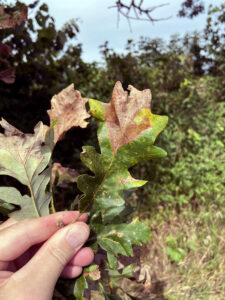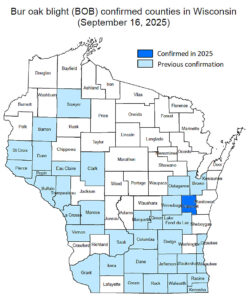
A wedge-shaped area of dead tissue at the tip of a bur oak leaf from a tree infected with bur oak blight. / Photo Credit: Wisconsin DNR
By Bill McNee, DNR Forest Health Specialist, Oshkosh
Bill.McNee@wisconsin.gov
Recent laboratory examination has confirmed the presence of bur oak blight in Calumet County. The disease affects only bur oaks and is caused by the fungus, Tubakia iowensis.
Calumet County is the 35th Wisconsin county to have a confirmed detection of bur oak blight. The disease has not been microscopically confirmed in all counties where bur oak grows and is likely present in additional counties. Bur oak blight was first reported in Midwestern states in the 1990s.

A map of Wisconsin counties showing confirmed bur oak blight occurrences in light blue. The latest find, in Calumet County, is in dark blue. / Map Credit: Wisconsin DNR
Symptoms of bur oak blight start appearing in late July and August and increase in severity as the season progresses. Late-season symptoms of bur oak blight include a wedge-shaped area of dead tissue on many of the leaves and purple-brown lesions on the underside of the leaf veins. The disease is generally more abundant in years when the spring and summer weather is wetter than average.
Disease symptoms usually start in the lower branches and progress up the canopy during the year. Severely affected bur oaks can lose vigor and may die after many years of infection or be attacked by opportunistic organisms such as Armillaria root disease and twolined chestnut borer.
Minnesota DNR fact sheet with information about management options for bur oak blight can be found online.
If you suspect bur oak blight on your property, please contact your regional DNR Forest Health specialist.
